Physical Address
304 North Cardinal St.
Dorchester Center, MA 02124
Physical Address
304 North Cardinal St.
Dorchester Center, MA 02124
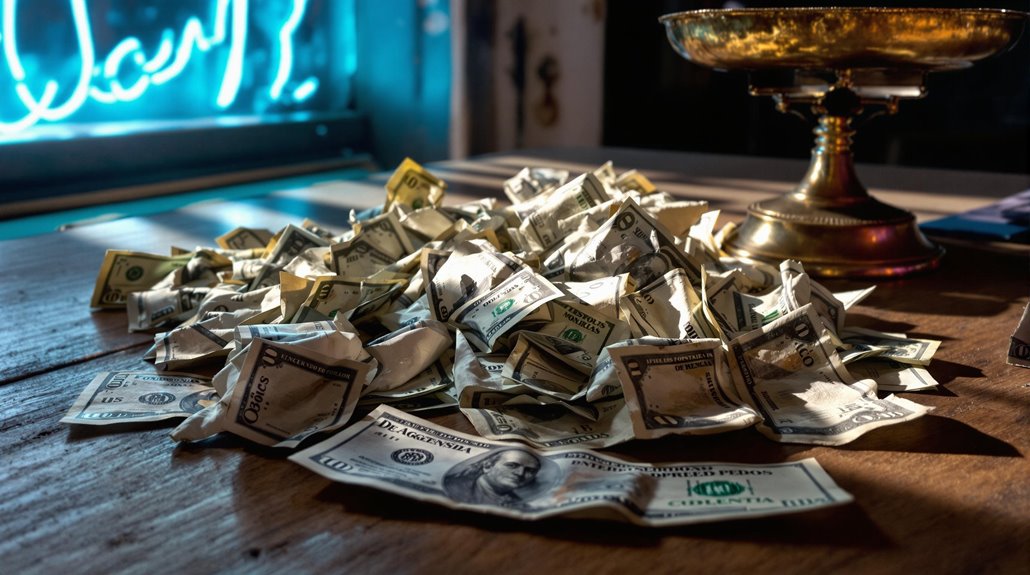
In Argentina, you'll encounter two vastly different exchange rates: the official rate and the informal "dolar blue" rate, which can double your purchasing power. While ATMs and credit cards use official rates, savvy travelers opt for Western Union or legitimate money exchange houses to access better rates. Daily expenses, from dining to accommodation, fluctuate based on which rate you're using, making it essential to understand this dual-currency system before exploring Buenos Aires's lively streets.

While Argentina's official peso has remained the country's primary currency since 1992, the nation's complex history of economic instability has given birth to a fascinating parallel currency market.
The roots of this system trace back to the 1980s when severe exchange controls first prompted Argentinians to seek alternative ways to protect their savings. During the hyperinflationary period of 1989, the parallel market gained significant momentum as citizens lost faith in the peso's stability.
The economic landscape shifted dramatically in 1995 with the emergence of the Red de Trueque, a barter network that demonstrated the population's willingness to embrace alternative currency systems. The dolar blue market emerged as a crucial unofficial exchange rate for those seeking to protect their assets from devaluation. Today, with the peso experiencing a staggering 272% annual inflation rate, citizens continue to seek refuge in parallel markets to preserve their wealth.
The daily reality of managing money in Argentina demands a unique set of skills, as residents must navigate between multiple exchange rates that affect every aspect of their lives.
Managing money in Argentina requires juggling multiple exchange rates, transforming everyday financial decisions into complex calculations.
You'll need to track the blue dollar rate constantly when paying for groceries and utilities in pesos, while your rent might be negotiated in USD to avoid peso volatility.
If you're planning to live or travel in Argentina, you'll want to maintain separate accounts – one in pesos for daily expenses and another in USD for major purchases. Most Argentines can only exchange a maximum of $200 at the official rate per month, making informal channels a necessity.
When shopping, you'll notice electronics and other goods often display dual pricing, with USD tags reflecting blue rates alongside peso equivalents.
Smart budgeting means converting 30-50% of foreign currency through informal channels to maximize your local buying power.
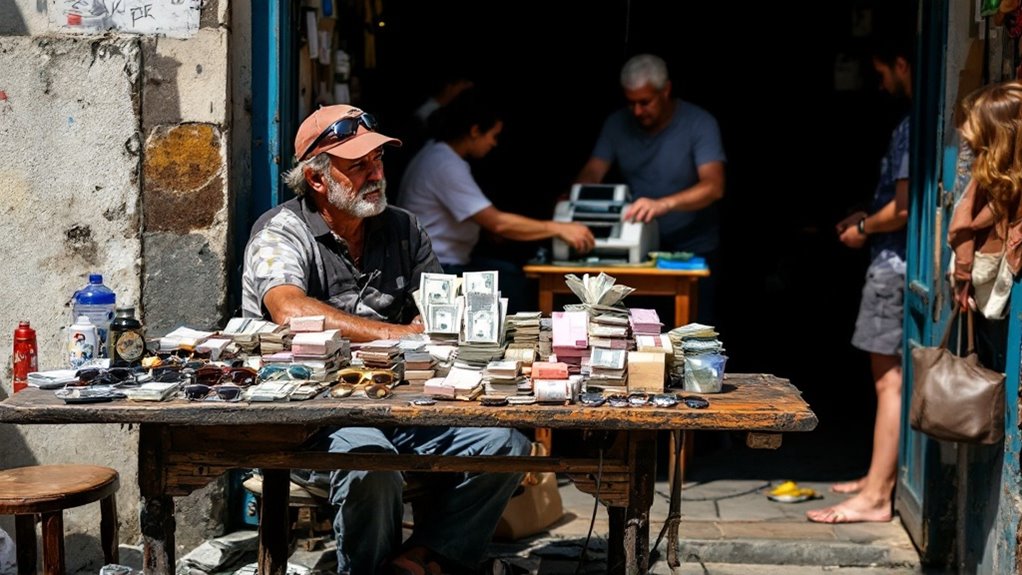
Deep within Argentina's financial underground, a complex network of street vendors known as *arbolitos* and hidden money houses called *cuevas* operates the crucial parallel currency market.
You'll discover these exchanges disguised as everyday businesses, from cafés to newsstands, where trust-based referrals and word-of-mouth keep operations discreet. These unofficial traders consistently offer better exchange rates than government-sanctioned outlets.
When you're looking to exchange currency through this network, keep in mind:
While technically illegal, the blue dollar network has become a significant financial survival tool for locals and travelers traversing Argentina's complex economy.
Living through Argentina's tumultuous financial history has taught generations of citizens that keeping savings at home isn't just a quirky habit – it's a survival strategy.
When you look at the numbers, it's easy to understand why: the peso lost 90% of its value since the early 2000s, and inflation reached a staggering 211% in 2024 alone.
Many Argentines don't trust banks after multiple crises where accounts were frozen and savings were forcibly converted to worthless bonds.
Instead, they've developed creative ways to store U.S. dollars at home, hiding them in everything from board game boxes to bookshelves.
This practice, known as keeping "mattress dollars," has become so common that safety deposit box waiting lists are now the norm at local banks.
The government's recent implementation of a 30% tariff on dollars has only strengthened citizens' resolve to keep their savings hidden at home.
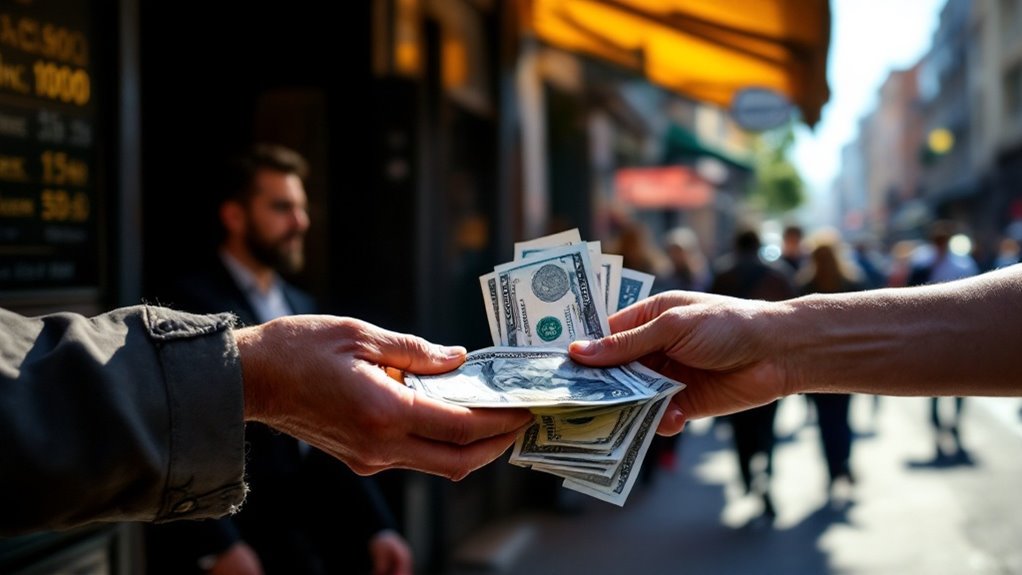
When planning your trip to Buenos Aires, traversing the city's complex currency exchange system might seem overwhelming at first glance.
You'll discover various options for converting your dollars or euros, each with distinct advantages and considerations. While official exchange bureaus offer security, they'll give you lower rates than the parallel "blue dollar" market. Remember that exchanging larger denomination bills typically yields better rates.
For the best exchange experience, follow these essential tips:
Argentina's tumultuous history with inflation has left lasting scars on its economy and society that you'll discover need to understand before visiting the country. Since 1945, the nation has weathered four devastating hyperinflationary cycles, with inflation reaching a staggering 3,000% in 1989-1990.
During the height of inflation, citizens resorted to storing wealth in U.S. dollar assets as a defense against their rapidly devaluing currency.
You'll observe these economic wounds still fresh today, as the peso continues to struggle, losing 66% of its value against the USD since 2018.
The country's attempts to stabilize its currency, including the 1991 peso-dollar parity plan and various IMF bailouts, haven't provided lasting solutions.
When you're planning your trip, keep in mind that Argentina's current annual inflation rate hovers around 45%, and currency controls implemented in 2019 have led to a thriving black market for dollars.
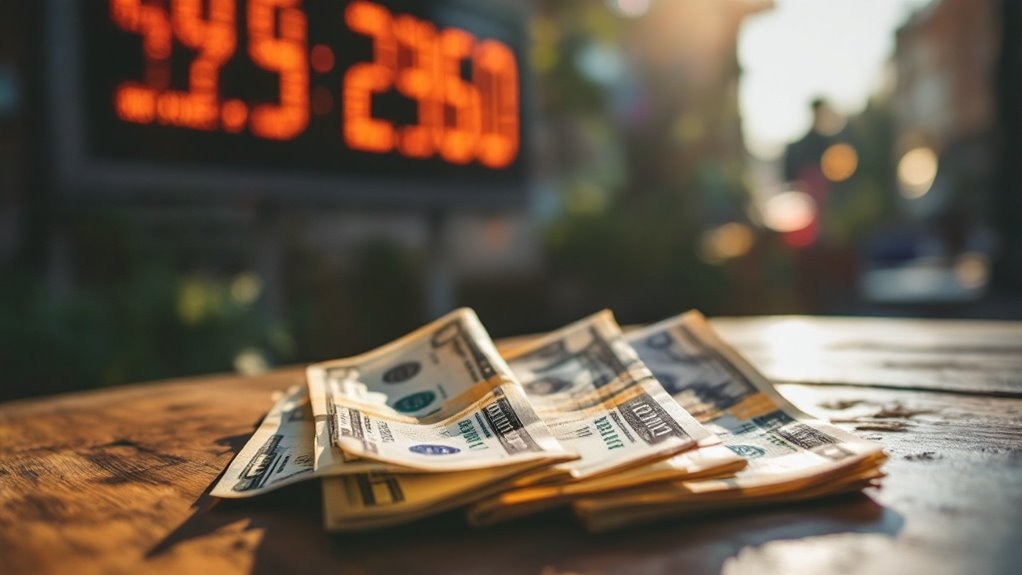
While traversing Argentina's complex currency landscape can seem intimidating, understanding the difference between official and Blue Dollar rates will greatly impact your travel budget. As of early 2025, you'll discover the official rate hovering around 1,056 ARS/USD, while the Blue Dollar trades about 12% higher at 1,180 ARS/USD.
Savvy travelers in Argentina can stretch their dollars 12% further by understanding the difference between official and parallel currency markets.
The country's annual inflation rate of 84.47% continues to drive currency depreciation and influence exchange dynamics.
Here's what you need to know about currency exchanges:
Keep in mind that while Blue Dollar transactions aren't strictly legal, they're widely tolerated, and no travelers have faced prosecution.
Despite recent signs of disinflation, Argentina's price landscape remains highly dynamic, with January 2025's inflation rate of 84.5% continuing to shape the real cost of goods and services across the country.
You'll notice the impact most clearly in restaurants and hotels, where prices have jumped 5.3% monthly, while housing and utilities costs climb by 4% due to eliminated subsidies.
If you're planning to shop, you might find some relief in clothing and footwear, where prices have dropped 0.7% amid weak consumer demand. Recent developments in the exchange rate have created online shopping discounts of up to 40% for international buyers.
Food costs, however, continue to rise at 1.8% monthly, hitting your wallet harder in some regions.
While the official peso rate stands at around 800 to the dollar, you'll need to factor in the parallel market rates when budgeting for your daily expenses.
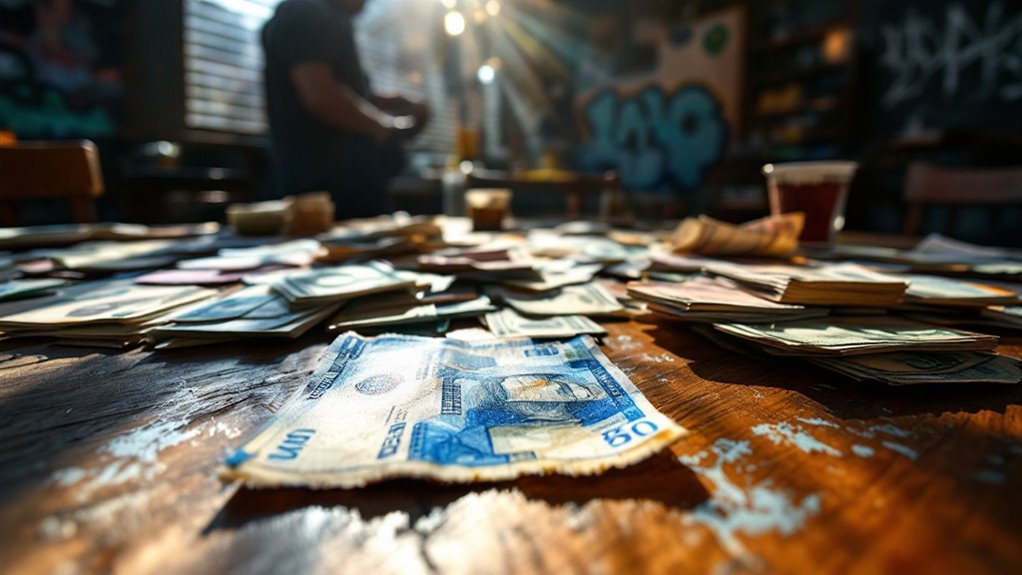
The deep-rooted distrust in Argentina's banking system continues to shape how you'll need to manage your money during your visit. Since the 2001-2002 financial crisis, when bank deposits were frozen and many lost their savings, Argentines have developed alternative ways to handle their finances, and you'll need to adapt accordingly.
Watch out for high ATM fees and withdrawal limits, and don't count on easily accessing credit cards or bank services during your stay. With high inflation at 28% predicted for 2018, keeping money in local currency could significantly decrease your purchasing power.
Since Argentina's economic turbulence in the 1930s, living between two currencies has become deeply woven into the nation's cultural fabric.
Argentina's dual-currency life isn't just economics – it's a cultural inheritance shaped by nearly a century of financial uncertainty.
You'll discover Argentines checking the blue dollar rate before any major purchase, treating it as a daily ritual much like reading the morning news.
In this dual-currency reality, you'll observe how families pass down USD savings traditions as insurance against peso devaluation, while real estate transactions happen exclusively in dollars.
If you're a local professional, you might find yourself converting your peso salary to USD through informal exchange houses, joining the middle-class practice of working multiple jobs to accumulate dollars for future expenses.
These quotidian rituals surrounding dollar transactions have become an integral part of Argentine society, shaping daily economic behaviors and social norms.
The cultural impact runs deep, with even media outlets using the blue dollar rate as a "social thermometer" to gauge national sentiment during times of crisis.
Living in Argentina's dual currency world isn't just about numbers – it's a daily reality where you can observe 75% of citizens keeping their savings in US dollars rather than pesos. Whether you're planning a visit or trying to understand this unique economic landscape, you'll need to navigate both official and parallel markets carefully. By staying informed and adapting to local financial practices, you'll get the most value from your money in this complex monetary system.